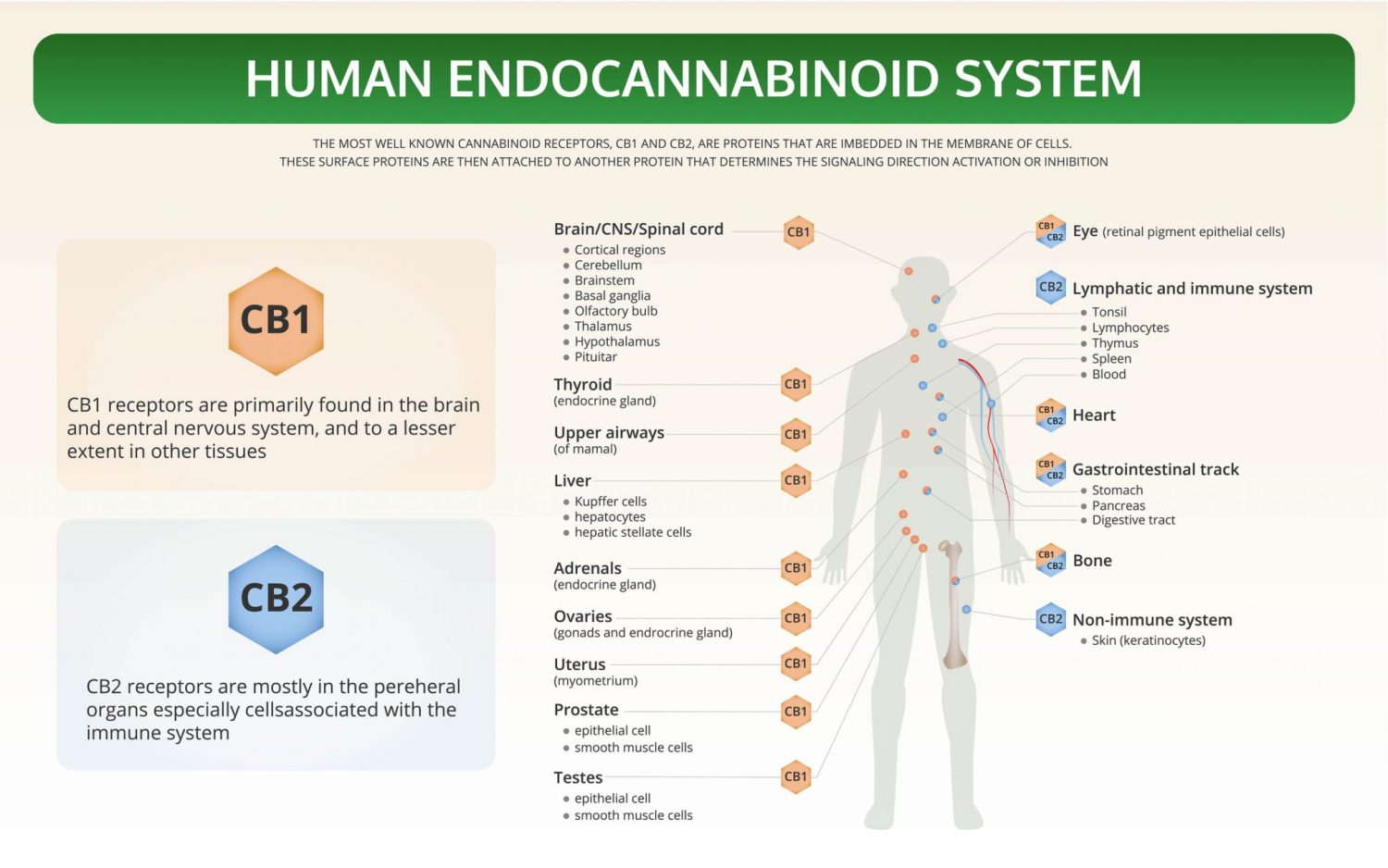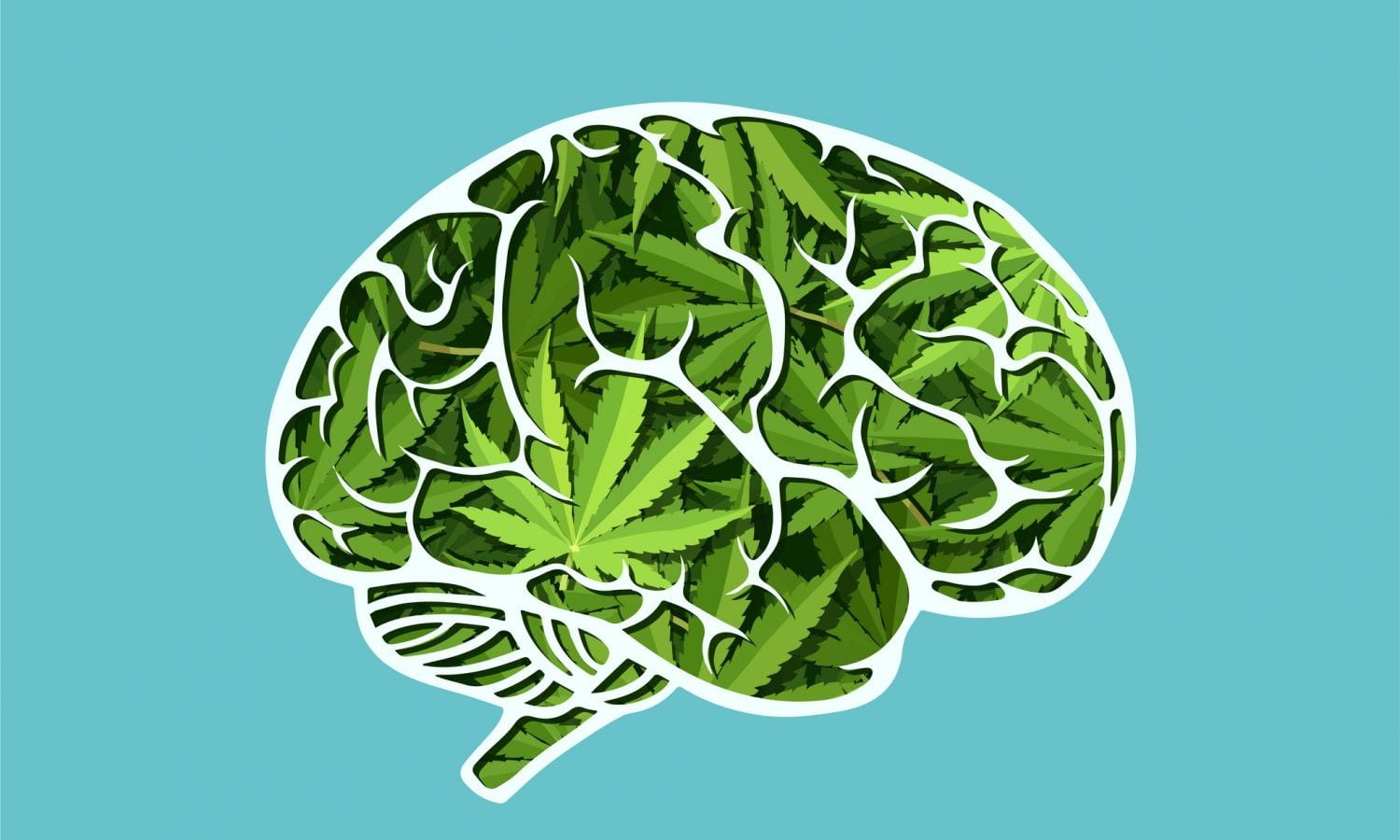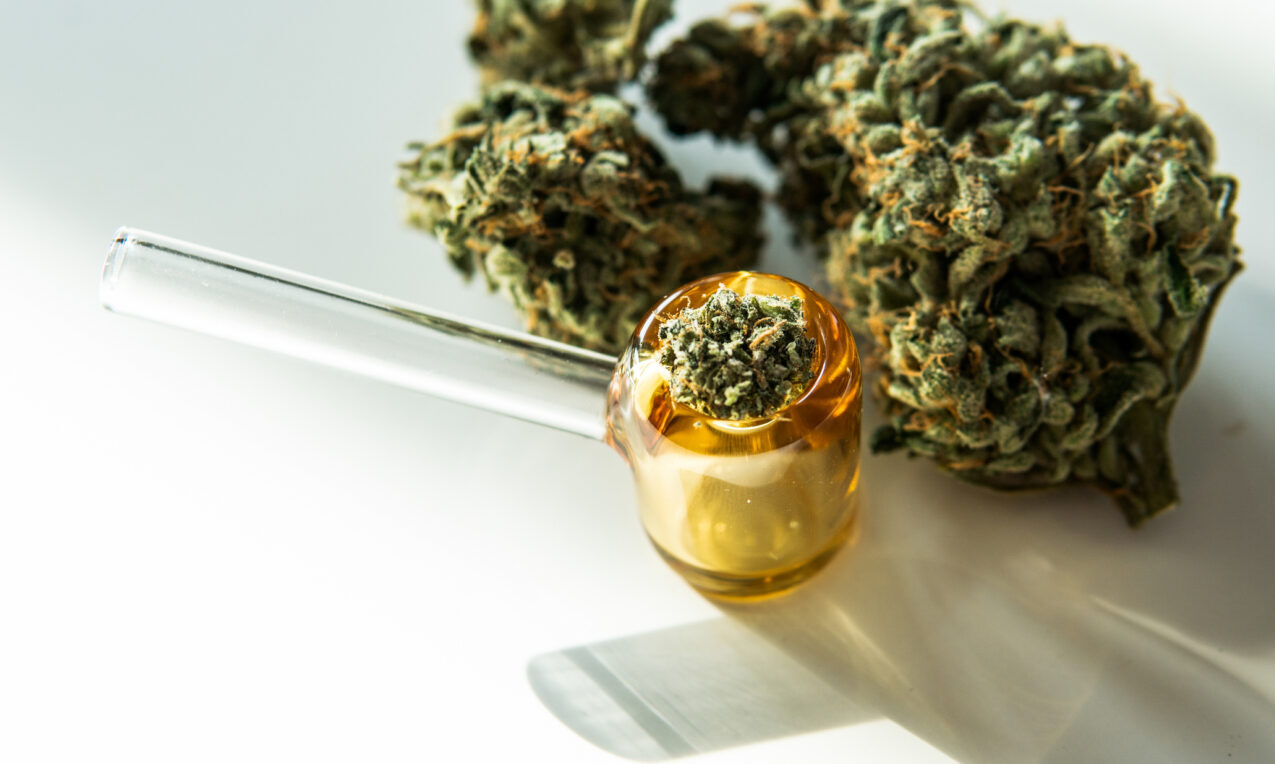Our environment and the decisions we make in our daily life can impact our ECS in remarkable ways, giving us the power to improve our wellbeing naturally.
This article originally appeared on Jointly and has been reposted with permission.
According to experts in cannabis wellness, there are 15 factors that can impact your cannabis experience. In some ways, your unique endocannabinoid system (ECS) may be the most important factor impacting your cannabis experience.
In this article, we will present a clear breakdown of the ECS; we will explore how this remarkable system bridges the body and mind; and we will discuss different ways you can impact your ECS to improve your health and wellbeing.
Your Unique Endocannabinoid System
Did you know that your ECS is unique? If you have ever tried a cannabis product that helps your friend relax and refresh, but when you take it you feel energized and uplifted, that may be because your ECS is different from your friend’s.
Not only is there genetic variation in the human ECS, but also the decisions you make in your day-to-day life can influence your individual ECS. For example, your diet, stress levels, sleep, and exercise can change your endocannabinoid tone.
Endocannabinoid (eCB) tone refers to the overall state of your ECS. Specifically, eCB tone reflects the levels of eCBs, their synthesis and catabolism, and “the relative density of cannabinoid receptors in the brain.”
What Does the Endocannabinoid System Do?
The primary function of the ECS in organisms is to maintain homeostasis, or to maintain stability in an organism’s internal environment in response to changes in the external environment. The homeostatic role of the ECS is summarized as, “relax, eat, sleep, forget, and protect.” Additionally, the ECS plays an important role in regulating cell division, neuroplasticity, metabolism, pain, emotional memory, inflammation, and immune processes.
Given the various functions of the ECS, it is no surprise that cannabis can be used for a variety of wellness goals. For example, you can use cannabis for recovering after a workout, focusing and creating, improving sleep, relieving mild pain, or improving social experiences.

About time/Getty Images
What is the Endocannabinoid System?
In humans, the ECS is made up of the type 1 cannabinoid receptor (CB1) and the type 2 cannabinoid receptor (CB2), the endogenous ligands (AEA and 2-AG) that are also known as eCBs, and the enzymes that produce and degrade the ligands.
Ligands are signaling molecules that bind to receptors on cells. When a ligand binds to a receptor on a cell, it produces an effect in the cell. Usually receptors only accept one (or a few) specific ligands. The eCBs 2-AG and AEA are found “in all tissues, organs and bodily fluids thus far investigated.”
RELATED: 10 Ways Cannabis Can Enhance Your Day
Both eCBs activate the CB1 and CB2 receptors, as well as the vanilloid receptor (TRPV1), which plays a role in sensing temperature and pain. CB1 and CB2 receptors are part of the superfamily of “G-protein coupled receptors,” which means they are proteins in the membranes of cells used to convert extracellular signals into intracellular responses.
CB1 receptors are found on neurons throughout the brain and the peripheral nervous system, as well as in muscle tissue, bone, and variety of other tissue types. CB2 receptors are primarily found on immune cells, although they are also found on bone and liver cells, as well on neurons in the brain and peripheral nervous system.
What Are Endocannabinoids?
While CB receptors are composed of proteins, eCBs are lipids. Lipids are organic compounds that don’t dissolve in water (fats and oils). As a result, the ECS can be described as a “complex network where endogenous bioactive lipid signals are produced by cells and released ‘on demand’.”
As we discussed, eCBs are ligands to the CB receptors. The eCB 2-AG is a “moderate affinity, CB1/CB2 full agonist”, while AEA is a “high affinity, CB1-selective partial agonist” and a low affinity, CB2 partial agonist. In biology or biophysics, affinity refers to the strength by which two or more molecules bind. High affinity means a strong molecular interaction.
When a ligand activates a receptor to produce a cellular response, it is called an agonist of that receptor. When a ligand binds to a receptor, does not produce a cellular response, and blocks agonists from binding, it is called an antagonist.
RELATED: Is Marijuana A Depressant?
AEA is a partial agonist of CB1 and CB2, which means that AEA can activate the CB receptors, but is unable to “induce maximal activation.” 2-AG is a full agonist of CB1 and CB2 receptors, so it can induce maximal activation of both receptors.
2-AG and AEA are released when an organism needs them (“on demand”), but the eCBs are rapidly broken down after they activate CB1 or CB2. As a result, eCB concentration is determined by the rate at which the enzymes break them down. AEA is catabolized by the enzyme FAAH, and 2-AG is catabolized by the enzyme MAGL, as well as other enzymes.
What is the Endocannabinoidome?
Scientists have found a variety of “CB1 receptor interacting peptides and a series of arachidonic acid derivates that generate endocannabinoid-like effects”, as well respective receptors and enzymes for these molecules. This expanded ECS is called the endocannabinoidome (eCBome).
Recent research indicates that the non-euphoric effects of cannabinoids like CBD or THCV are due to their interactions with the eCBome.
How Does the Endocannabinoid System Work?
How does the ECS maintain homeostasis in an organism?
You can think of the ECS as “a lipid-signaling system…that modulates neurotransmitter release.” When eCBs (or exogenous cannabinoids) bind to CB receptors on neurons, the release of that neurotransmitter is suppressed. For example, if eCBs attach to a GABAergic neuron, the release of GABA will be suppressed.
Why Does THC Get You High?
Cannabis contains a wide variety of chemical compounds including hundreds of cannabinoids, terpenes, flavonoids, and other compounds. Many of these compounds exert complex biological effects. However, THC is the primary intoxicating cannabinoid in cannabis. But why does THC get you high?
THC mimics the eCBs in your body and binds to CB1 receptors in your brain, creating a euphoric effect. Researchers have found that the expression of CB1 receptors in the brain “correlates with the psychoactive effects of cannabis.”
Specifically, CB1 receptors are found in areas of the brain related to “appetite, memory, fear extinction, motor responses, and posture,” all of which are affected by THC. CB1 receptors are concentrated primarily on presynaptic terminals of GABAergic and glutamatergic neurons in the brain. GABA is the primary inhibitory neurotransmitter and glutamate is the primary excitatory neurotransmitter, and their balance determines the brain’s overall level of excitation.

The Evolution of the ECS
Scientists have determined that the ECS has ancient evolutionary roots. Cannabinoid receptors are found in “mammals, birds, amphibians, fish, sea urchins, mollusks, leeches, and Hydra vulgaris,” which has the simplest nervous system of any known organism. Insects and protozoa do not have an ECS.
Genetic researchers have traced back the diverse cannabinoid (CB) receptor genes to one ancestral CB gene that predates the divergence of vertebrates and invertebrates. As a result, the “primordial CB receptor” evolved at least 600 million years ago, around the time of the Cambrian explosion. Now that we have a solid understanding of the ECS, we can explore how genes, environment, and actions may impact your ECS—and also your cannabis experience.
Do Genes Affect Your Cannabis Experience?
A 2018 literature review titled “Pharmacogenetics of Cannabinoids” notes that a “patient’s response to cannabinoid treatment may have a genetic background, which depends on gene polymorphism involved in the action, metabolism, and the transport of these substances in the organism.”
Pharmacogenetics is a field of study that tries to determine why individuals experience variable responses to the same drug. For example, some people are unable to feel the effects of edibles even when they eat very high doses of THC.
Studies have shown that two people can have completely different levels of THC metabolites if one of them produces a certain form of an enzyme. The enzyme is called CPY2C9 and it comes in different forms depending on which variant of the CPY2C9 gene one has. A rare subtype of this gene produces a variant of the enzyme that metabolizes THC faster than normal, making it exceedingly difficult for these individuals to feel the effects of edibles.
However, cannabis can be taken through a variety of ingestion methods, so you can still get wellness benefits from cannabis even if edibles don’t work for you. Individuals with this genetic variant will still feel the effects of inhaled cannabinoids.
In the next section, we will explore some controversial findings regarding genetic variations in the human ECS.
What Do My Endocannabinoid Genes Mean?
Many gene testing services can tell you which ECS gene variants you carry. Genes are sequences of nucleotides in DNA that encode the synthesis of a gene product, which is either RNA or protein.
Genes can acquire mutations in their sequence, which are called variants. Variants can encode slightly different versions of a protein.
Two widely studied gene variants in the ECS are the CNR1 gene, which encodes the CB1 receptor, and the FAAH gene, which encodes the enzyme FAAH. As discussed, FAAH breaks down the eCB AEA. People with gene variants of CNR1 or FAAH will have slightly different versions of the CB1 receptor or the enzyme FAAH. In recent years, researchers have been trying to link these genetic variants to different disorders or phenotypes.
For example, researchers have studied a CB1 polymorphism in humans and associated it with a “protective effect…against stress-related” disorders like depression or PTSD. A 2015 New York Times article titled “The Feel Good Gene” discussed a genetic variation of the FAAH gene that results in people having lower levels of FAAH. Less FAAH breaking down AEA means increased levels of AEA.
In animal studies, mice genetically engineered to have this gene display lower levels of anxiety behavior and decreased “fear learning.”
It is important to note that the New York Times article draws some dubious conclusions. The article claims that people with this genetic variant are lucky because they are resistant to anxiety, more easily able to forget fearful experiences, and thus will be less likely to be addicts. However, other studies have shown the opposite: that this genetic variant is associated with “increased risk for addiction” in humans.
In reality, numerous studies have indicated that environment trumps genetics when it comes to addiction, mental health, and disease. If you have taken a genetic test and determined which ECS gene variants you have, you should consider it to be interesting data, not something that determines your life or future.

Rare Genetic Variations of the ECS
In some rare cases, genetic variation in the ECS produces remarkable situations. For example, researchers studied a woman who experienced no pain while giving birth and who had never experienced anxiety. She reported frequently burning herself without pain, only noticing when she smelled her burning skin, but healing rapidly and without scars. Additionally, she reported never panicking, even in dangerous or fearful situations.
She had a gene that produces a variant of FAAH that is less effective than normal, increasing levels of AEA. However, researchers also discovered she had a rare mutation in a “pseudogene” they called FAAH-OUT. The combined effect was a “loss of function of FAAH in the patient.”
Her remarkable inability to feel pain was thought to be related to her increased levels of AEA, which led to increased signaling at CB1 receptors. As for her lack of anxiety, physical and emotional pain are distinct, but brain regions that process emotional and physical pain overlap.
In the next section, we will dive into the ways your environment, emotional state, and actions can impact your ECS—for better or for worse.
How the ECS Links Your Body and Mind
One of the most important functions of the ECS in mammals is to return an organism to homeostasis after stress. Essentially, stress (including psychological stress) affects your ECS. In short, stress impacts your ECS and your ECS impacts your stress response. That’s why researchers believe the ECS “represents a microcosm of…mind-body medicine.”
When mammals experience stress, they have increased activity in the hypothalamic-pituitary-adrenal axis (HPA axis). The hypothalamus is a gland in the brain that is involved in hormonal responses and controls the activity of the pituitary gland, which secretes hormones into the bloodstream. In general, the HPA axis serves to mobilize a response to stress. The amygdala is another brain region involved in stress, particularly a section called the basolateral amygdala (BLA). The amygdala is one of two almond shaped clusters deep in the brain that govern the fear response.
The amygdala is the primary gateway through which sensory information is converted into an emotional response. Sensory information enters the BLA, where it is processed before it is sent out to the emotional processing portion of the brain. As a result, a mammal’s emotional arousal is thought to be governed by how sensory information is processed in the BLA.
Researchers have studied the role of the ECS in stress-induced anxiety. They found that if you disrupt eCB signaling in the amygdala, either through genetic modification or with a drug, the effects will mirror stress-induced anxiety.
They injected a CB1 antagonist (blocks eCBs from activating CB1 receptors) into the BLA of rats. Blocking CB1 receptors in the BLA caused an increase in HPA activation, a spike in anxiety behaviors, and a decline in fear extinction. Fear extinction is the ability to forget fearful memories, and “deficits in extinction learning are the hallmark of human anxiety disorders.”
The researchers concluded that “eCB signaling in BLA constrains activation of the stress response and anxiety.” Specifically, CB1 activation inhibits HPA axis activation, which decreases stress and anxiety. They also determined that “collapse of endocannabinoid signaling in the amygdala underlies stress-induced anxiety.”
How Stress Impairs the Endocannabinoid System and How to Fix It
When a mammal experiences stress, the HPA axis is activated and stress hormones are released. Additionally, FAAH is activated, rapidly breaking down AEA in a variety of regions in the brain, including the amygdala.
Less AEA results in less CB1 signaling on glutamatergic (Glu) neurons in the BLA. Less CB1 signaling on Glu neurons means that more glutamate is released, increasing excitation in the amygdala. A negative feedback loop is triggered when there is a “hypersecretion” of cortisol (excess secretion), which triggers “on demand” synthesis of eCBs. The eCBs activate CB1 receptors on Glu neurons and diminish or suppress the output of Glu, returning the organism to homeostasis.
After an acute stress, “AEA-CB1 signaling [in the BLA] becomes particularly important in the mitigation of stress-induced anxiety.” Chronic stress alters the ECS and causes a downregulation of CB1 receptors in the brain, decreased levels of eCBs, and impaired eCB signaling. As a result, neurons have less eCB signaling on CB1 receptors and neuronal excitability goes up.
Researchers have found that “prolonged psychological stress and sleep deprivation…inactivate BLA AEA-CB1 signals.” So, if you have ever found yourself feeling cranky or a little anxious due to sleep deprivation, it might be because eCB signaling in your BLA is temporarily impaired.
Stress management and a variety of other activities may reverse the effects of chronic stress on eCB signaling. For example, mice given access to a running wheel recover chronic stress induced deficits to their ECS. Additionally, “clinical anecdotes suggest that stress-reduction techniques, such as meditation, yoga, and deep breathing exercises impart mild cannabimimetic effects.”
How Exercise Boosts Your ECS
Many of the benefits of exercise are related to its effects on your ECS. For example, the famous “runner’s high” has been found to be caused by eCBs rather than endorphins.
Essentially, exercise acts as a stressor that activates the HPA axis and the ECS, elevating levels of eCBs and increasing CB1 signaling.
Exercise produces different effects in different regions of the brain. For example, exercise increases CB1 signaling in the hippocampus, which is how exercise affects motivation, memory, and neuroplasticity. The hippocampus is a part of the brain that plays a role in memory formation.
In animal studies, exercise has been found to increase reward signaling in the brain, decrease stress, and increase fear extinction. Exercise produces these benefits by impacting the hypothalamus.
Specifically, exercise increases levels of AEA in the hypothalamus, increases HPA activation, and increases CB1 and dopamine signaling.
Different types of exercise, or exercising in different conditions, may produce different effects on the ECS. For example, strenuous hiking at high altitude significantly increases serum AEA from baseline, more so than strenuous hiking at normal altitude.

How Your Actions Impact Your ECS
Your daily decisions can impact your ECS in a variety of ways.
For example, when you use high doses of cannabis regularly, you build up a tolerance that is largely due to your brain decreasing expression of CB1 receptors, so there are less CB1 receptors to which THC can bind.
There are a variety of activities other than exercise that have been shown to positively impact your ECS. For example, massages have been shown to increase serum AEA by 168%, while singing in a choir was found to increase serum AEA by 42%.
In animal studies, social play enhanced CB1 activation in the amygdala and nucleus accumbens, a part of your brain involved in reward and motivation. As we established, enhanced CB1 signaling in the amygdala is associated with lower anxiety. Remarkably, this mechanism (enhanced CB1 signaling in the amygdala) may be one of the reasons ice baths and cold exposure is associated with mental health benefits.
How Cold Affects the ECS
Many prominent figures from former Twitter CEO Jack Dorsey to Lady Gaga have touted the mental health benefits of cold-water exposure, as popularized by Wim Hof. Please note that cold exposure is a significant stress on the body and can be dangerous. We are not discussing the treatment of any stress or anxiety disorders. The information below is for educational purposes, is based on animal studies, and is not meant to be prescriptive of what one should do. Please consult your doctor before making any changes to your lifestyle or routine.
A recent study sheds light on the remarkable way that cold alters the ECS. A group of researchers observed that exposing rats to cold led to a significant reduction in anxiety and depressive behaviors. Given the evidence that eCB signaling in the amygdala gates the stress and anxiety response, they hypothesized that cold might alter eCB signaling in this region of the brain.
Remarkably, they found that one hour of cold exposure led to a 40% increase in density of CB1 receptors in the amygdala. The researchers concluded that this effect may be responsible for the dramatic decrease in stress and anxiety behaviors they observed following cold exposure.
How Cannabis Impacts Your ECS
Cannabis can have either a stimulating or a suppressive effect on your ECS. Cannabis and cannabis products are “complex polypharmaceuticals, consisting of dozens of cannabinoids, as well as terpenes, flavonoids, and other compounds.”
Acute cannabis exposure may “kickstart” the ECS by increasing CB1 receptor density, increasing sensitivity of CB1 receptors to cannabinoids, and increasing AEA biosynthesis. However, chronic, high dosing of THC produces the opposite effect. CB1 receptors are downregulated, and tolerance goes up. The dividing line between “acute” and “chronic” cannabis use is a grey zone and likely differs among individuals.
However, cannabis is not just THC, and different compounds in cannabis have distinct effects. For example, CBD boosts neurogenesis (generation of new neurons) in the hippocampus. Adding CBD to THC enhances CB1 expression in the hippocampus and hypothalamus. Additionally, CBD has been shown to inhibit “the cellular uptake of AEA and its breakdown by FAAH,” increasing AEA signaling. CBG is also a relatively potent inhibitor of AEA cellular reuptake.
In conclusion, the ECS is a complex system that is critically important for our wellbeing. Our environment and the decisions we make in our daily life can impact our ECS in remarkable ways, giving us the power to improve our wellbeing naturally. We hope this article has inspired you to get started on your cannabis wellness journey and harness the power of your unique ECS.
Use the Jointly App to Get More Out of Cannabis
Have you started your cannabis wellness journey? Jointly is a new cannabis wellness app that helps you discover purposeful cannabis consumption so you can achieve your wellness goals with cannabis and CBD. On the Jointly app, you can find new cannabis products, rate products based on how well they helped you achieve your goals, and track and optimize 15 factors that can impact your cannabis experience. These 15 factors include your dose, the environment in which you consume cannabis, who you are with when you ingest, how hydrated you are, the quality of your diet, how much sleep you got last night, and more. Download the Jointly app on the App Store or the Google Play Store to get started on your cannabis wellness journey.
Sam is the content Director at Jointly, a cannabis wellness company powered by a proprietary data platform to help people reach their full potential. The company was created on the premise that purposeful cannabis consumption is the key to unlocking a better you.


